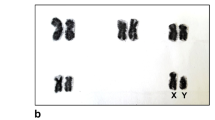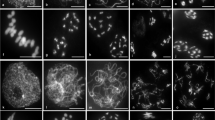Abstract
Within a total of 50 analyzed specimens a male individual of Trichomycterus davisi has been recorded with 81 chromosomes including 60 metacentric, 18 submetacentric and three subtelocentric chromosomes. When compared with diploid individuals (2n = 54) and the morphological standard of chromosomes, this male is a triploid with 3n = 81 chromosomes. Since staining with silver nitrate indicates three active nucleolar organizer regions (NORs), the three NOR-bearing chromosomes in this individual are genetically active. Analysis of the synaptonemal complex (SC) by electronic microscopy shows that there is an incomplete pairing of the third set of chromosomes in the triploid individual.
Similar content being viewed by others
References
Almeida-Toledo, L.F., F. Foresti & S.A. de Toledo Filho, 1985. Spontaneous triploidy and NOR activity in Eigenmannia sp. (Pisces, Sternopygidae) from the Amazon basin. Genetica 66: 85–88.
Al-Sabti, K., B. Kurelec & N. Fijan, 1983. Spontaneous triploidy and tetraploidy in the common carp (Cyprinus carpio L.). Vet. Arhiv. 53(5): 217–223.
Amemiya, C.T. & J.R. Gold, 1986. Chromomycin A3 stains nucleolus organizer regions of fish chromosomes. Copeia 1986: 226–231.
Bertollo, L.A.C. & C.A. Mestriner, 1998. The X1X2Y sex chromosome system in the fish Hoplias malabaricus. II. Meiotic analyses. Chromosome Res. 6: 141–147.
Bertollo, L.A.C., C.S. Takahashi & O. Moreira-Filho, 1978. Cytotaxonomic considerations on Hoplias lacedae (Pisces, Erythrinidae). Rev. Bras. Genet. 1: 103–120.
Borin, L.A. & I.C. Martins-Santos, 1999. Karyotype characterization of three species of the genus Trichomycterus (Teleostei, Siluriformes, from Iguaçu river. Genetica 106: 215–221.
Centofante, L., L.A.C. Bertollo & O. Moreira-Filho, 2001. Comparative cytogenetics among sympatric species of Characidium (Pisces, Characiformes). Diversity analysis with the description of a ZW sex chromosome system and natural triploidy. Caryologia 54(3): 253–260.
Cuellar, O. & T. Uyeno, 1972. Triploidy in rainbow trout. Cytogenetics 11: 508–515.
Dias, A.L., F. Foresti & C. Oliveira, 1998. Synapsis in supernumerary chromosomes of Prochilodus lineatus (Teleostei, Prochilodontidae). Caryologia 51(2): 105–113.
Evans, G.M. & E.W. Davies, 1983. Fertility and stability of induced polyploids, 139 pp. in Kew Chromosome Conference II, edited by P.E. Brandham & M.D. Bennett. Allen and Unwin, London.
Fauaz, G., V.E. Vicente & O. Moreira-Filho, 1994. Natural triploidy and B chromosomes in the neotropical fish genus Astyanax (Characidae). Brazil J. Genet. 17(2): 157–163.
Foresti, F., C. Oliveira, P.M. Galetti Jr. & L.F. Almeida-Toledo, 1993. Synaptonemal complex analysis in spermatocytes of tilapia, Oreochromis niloticus (Pisces, Cichlidae). Genome 36: 1124–1128.
Galetti Jr., P.M.& E.M. Rasch, 1993. NOR variability in diploid and triploid forms of the amazon molly Poecilia formosa as shown by silver nitrate and chromomycin A3 staining. Rev. Bras. Genet. 16(4): 927–938.
Gilles, C.B., 1984. The synaptonemal complex in higher plants. CRC Crit. Rev. Plant Sci. 2(2): 81–116.
Giuliano-Caetano, L. & L.A.C. Bertollo, 1990. Karyotypic variability in Hoplerythrinus unitaeniatus (Pisces, Characiformes, Erythrinidae). II. Occurrence of natural triploidy. Brazil J. Genet. 13(2): 231–237.
Gold, J.R. & J.C. Avise, 1976. Spontaneous triploidy in the California roach Hesperoleucus symmetricus (Pisces, Cyprinidae) Cytogenet. Cell Genet. 17: 144–149.
Howell, W.M., & D.A. Black, 1980. Controlled silver-staining of nucleolus organizer regions with a protective colloidal developer: a 1-step method. Experientia 36: 1014–1015.
Loidl, J., K. Nairz & F. Klein, 1991. Meiotic chromosome synapsis in a haploid yeast. Chromosoma 100: 221–228.
Lozano, R., C. Ruiz Rejón & M. Ruiz Rejón, 1992. A comparative analysis of NORs in diploid and triploid salmonids: implications with respect to the diploidization process occurring in this fish group. Heredity 69: 450–457.
Malacrida, A.C.C.P., 2002. Características cromossômicas de algumas espécies de Astyanax (Characidae, Tetragonopterinae) da bacia do rio Tibagi, PR. Dissertação de Mestrado. Universidade Estadual de Londrina, Londrina, PR, Brasil, 95 pp.
Mestriner, C.A., L.A.C. Bertollo & P.M. Galetti Jr., 1995. Chromosome banding and synaptonemal complex in Leporinus lacustris (Pisces, Anostomidae): analysis of a sex system. Chromosome Res. 3: 440–443.
Mestriner, C.A., P.M. Galetti Jr., S.R. Valentini, I.R.G. Ruiz, L.D.S. Abel, O. Moreira-Filho & J.P.M. Camacho, 2000. Structural and functional evidence that a B chromosome in the characid fish Astyanax scabripinnis is an isochromosome. Heredity 85: 1–9.
Morelli, S., A.C. Bertollo & O. Moreira-Filho, 1983. Citogenetics considerations on the genus Astyanax (Pisces, Characidae). II. Occurrence of the natural triploidy. Caryologia 36(3): 245–250.
Ohno, S., 1970. Evolution By Gene Evolution. Springer Verlag, New York.
Ohno, S., 1974. Animal Citogenetics. Vol. 4, Chordata 1, Gerbruder Borntraeger, Berlin.
Oliveira, C., F. Foresti, M.G. Rigolino & Y.A. Tabata, 1995a. Synaptonemal complex analysis in spermatocytes and oocytes of rainbow trout, Oncorhynchus mykiss (Pisces, Salmonidae): the process of autosome and sex chromosome synapsis. Chromosome Res. 3: 182–190.
Oliveira, C., F. Foresti, M.G. Rigolino & Y.A. Tabata, 1995b. Synaptonemal complex formation in spermatocytes of the autotriploid rainbow trout, Oncorhynchus mykiss (Pisces, Salmonidae). Hereditas 123: 215–220.
Oliveira, C., F. Foresti, M.G. Rigolino & Y.A. Tabata, 1996. Paracentric inversion involving a NOR-bearing chromosome of rainbow trout (Oncorhynchus mykiss): electron microscopy studies of the synaptonemal complex. Caryologia 49(3-4): 335–342.
Portela-Castro, A.L.B., H.F. JÚlio-Junior & P.B. Nishiyama, 2001. New occurrence of microchromosomes B in Moenkhausia sanctafilomenae (Pisces, Characidae) from the Paraná river of Brazil: analysis of the synaptonemal complex. Genetica 110: 277–283.
Rasmussen, S.W., 1977. Chromosome pairing in triploid females of Bombyx mori analysed by three dimensional reconstruction of synaptonemal complexes. Carlsberg Res. Commun. 46: 347–360.
Romashov, D.D. & V.N. Belyaeva, 1965. Apud Valenti, R.J., 1975. Induced polyploidy in Tilapia aurea (Steindachner) by means of temperature shock treatment. J. Fish Biol. 7: 519–528.
Santos, J.L., 1993. Spreading synaptonemal complex from the grasshopper Clorthippus jacobsi: pachytene and zygotene observations. Hereditas 118: 235–241.
Schmid, M. 1982. Chromosome banding in Amphibia. VII. Analysis of the structure and variability of NORs in Anura. Chromosoma 87: 327–344.
Schweizer, D. 1976. Reverse fluorescent chromosome banding with Chromomycin and DAPI. Chromosoma 58: 307–324.
Solari, J.A., M.H. Thorne, B.L. Sheldon & C.B Gillies, 1991. Synaptonemal complexes of triploid (ZZW) chickens: Z-Z pairing predominates over Z-W pairing. Genome 34: 718–726.
Venere, P.C. & P.M. Galetti Jr., 1985. Natural triploidy and chromosome B in fish Curimata modesta (Curimatidae, Characiformes). Rev. Bras. Genet. VIII(4): 681–687.
Author information
Authors and Affiliations
Rights and permissions
About this article
Cite this article
Borin, L.A., Martins-Santos, I.C. & Oliveira, C. A Natural Triploid in Trichomycterus Davisi (Siluriformes, Trichomycteridae): Mitotic and Meiotic Characterization by Chromosome Banding and Synaptonemal Complex Analyses. Genetica 115, 253–258 (2002). https://doi.org/10.1023/A:1020667526552
Issue Date:
DOI: https://doi.org/10.1023/A:1020667526552




